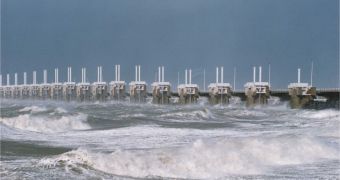In Holland, there is a millenary struggle between man and the sea.
700 years ago, on the western shore of the Netherlands the Zuider Zee (Southern Sea) gulf was formed, which flooded hundreds of cities. In 1420, the Meuse River broke the dams at the south of Dardrecht and the waters swallowed 70 villages, leaving over 10,000 victims. The phenomenon repeated 150 years later, when the sea water drowned over 30,000 people. In the end, in the night of 31st of January 1953, a strong tide accompanied by a hurricane raised the waters 3 m (10 ft) over the dams, provoking breaks in the dam that defended the southwest of the country, flooding 133 localities and over 160,000 hectares of cultivable land.
Such a cataclysm occurs just once in 300 years.
In the face of such repeated invasions of the waters, the Dutch engaged in a vast constructive work of chasing away the sea from their territory, fact that led to the recovery of 4,600 square km (1,800 square mi) (land called polder) of 6,000 square km (2,400 square mi) covered by the sea.
The most important arrangement plan was Delta Plan, started immediately after the 1953 flooding and finished in 1997 (with Hartelkering and Maeslantkering), stipulating the enclosure of all estuaries separating the Dutch islands, in the zone of the Rhine, Meuse and Escaut deltas (southwest Netherlands).
A giant dam is opened only for the access to the harbors of Rotterdam and Anvers, all the estuaries to the North Sea being secluded and the Dutch coast line shortened by 700 km (440 mi). Besides defending against flooding, the Delta Plan also had amongst its goals the buildings of secondary dams with sluices, through which a better repartition of the marine and fluvial waters would have been made, to avoid the increase of the salt concentration in the table waters, which have been harmful for agriculture but also for the human freshwater necessities.
Each isolated estuary has been turned in freshwater lakes with different uses (irrigations, fishing, tourism, nautical sports, and so on). After a series of hydrotechnical works made on the Rhine sector from 1958 to 1969, the operations passed to the construction of big sluices at the south of the Rhine mouth, at Heringvliet (finished in 1971), for the creation of a freshwater reservation which would have bound at the same time the sea and the two rivers, Rhine and Meuse.
With the 17 immerseble steel locks disposed on a length of 4.5 km (2.8 mi), the dam of Heringvliet impedes the salty sea water to get into the estuaries, letting just the freshwater of the rivers. The locks are opened only during the flow over of the Rhine and Meuse, when their debits get over 1,500 cubic meters per second.
But the most important of the 13 works of Delta Plan, to which the most advanced technique was employed, is the world's largest mobile "ecological" dam, which closes the estuary of the Oriental Escaut (Oosterschelde). The giant dam was made of three parts, with a total length of 2.8 km (1.8 mi) and 63 openings. The skeleton of the construction is made of 66 pillars made of precompressed concrete between each move the steel locks.
During the quiet periods, the locks are opened allowing the sea water to pass. In case of storm or oil spill, they are shut down; this happened just 23 time since 1986. The total surface of the locks' openings is about 18,000 square meters and was calculated for the difference between high tide and low tide to be 2.7 m (9 ft) near the port of Yerseke, on the extremity of the estuary.
The dam's construction started in 1976 and finished in the 1986, imposing the construction of another two secondary dams (Osterdam and Philipsdam in 1986 and 1987) for limiting the mouth of the estuary in its northeast and east sides.
The Oosteschelde dam impedes the action of the marine storms, maintaining a constant level of the waters, proper for intense navigation. The Escaut estuary is employed as nursery by 70 species of fish and mollusks (oysters), important in the local fishing industry.
The estuaries of the Oriental and Occidental Escaut are also the second wintering place for shore birds in Western Europe, after Wadden Sea in northern Netherlands. Without the mobile dam, 150 species of zooplankton and 140 of algae in the area would have been condemned to extinction, too.
But even the open dam of the Oriental Escaut influences the environment of the delta and the estuary, as the mouth of the estuary has now an opening of just 18,000 square meters compared to the initial 80,000.
Each tide, which had a volume of 2.5 billion cubic meters at the entrance of the estuary has now just 1.6, and lowered its amplitude from 3.4 m (11.1 ft) to 2.7 m where Yerseke is located, which is the local center of aquaculture. That's why the salty swamps got to the half of their former surface and former muddy terrains are now solid ground.
The mobile dam has been designed to last 200 years and it's considered one of the modern Seven Wonders of the World by the American Society of Civil Engineers.
The cost of operating the dam is ?17 million per year.

 14 DAY TRIAL //
14 DAY TRIAL //